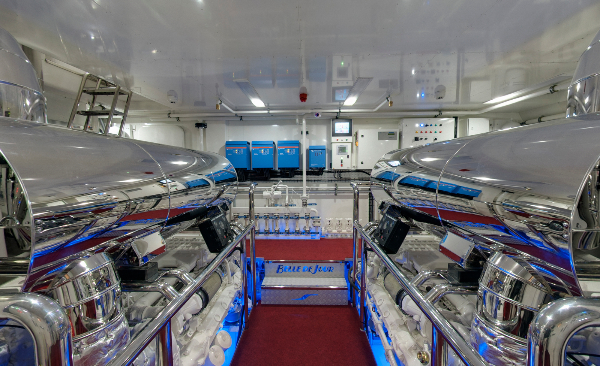MARPOL Annex VI - What you need to know
The New Year has brought with it the first elements of the IMO Tier III MARPOL Annex VI NOx regulations, but who does it effect, what constitutes an exemption and who benefits from a stay of execution?
After years of nervous industry anticipation, the advent of 2016 has seen the first elements of IMO Tier III’s MARPOL Annex VI nitrogen oxide (NOx) regulations come into force. SuperyachtNews.com speaks with Udo Kleinitz, Secretary General of the International Council of Maritime Industry Associations (ICOMIA), about who the implementation affects and what owners and industry professionals need be aware of.
The rule stipulates that all engine installations with a power output of more than 130kW, whether it be a propulsion or auxiliary engine, that are to be used within Emission Control Areas (ECAs) for NOx (the only current example being assigned to the North American East and West Coast, Hawaii and the US Caribbean) must be fitted with systems that ensure the vessels produce 74 per cent less NOx pollution than previously allowed under IMO Tier II. There are however, exemptions and delays to consider.
“If the vessel is shorter than 24m there is an exclusion for vessels designed and used solely for recreational purposes,” starts Kleinitz. This theme of ‘recreational purpose’ pervades all the forthcoming exemptions and delays.
It must be clear within any vessel’s documentation, that wishes to benefit from the exemptions and delays discussed within this article, that it will exclusively be in recreational use, that is, intended solely for use as a sport or leisure craft. If this is not made explicitly clear you are at risk of failing to benefit from any exclusion or delay.
“We have followed up with the key flag administrations related to our sector to ensure that charter yachts are considered ‘recreational’ within the specific provisions applicable to recreational vessels.” continues Kleinitz.
“We went to the Cayman Islands, Malta, The Marshall Islands, the UK Maritime and Coastguard Agency and others. The importance of this is, once an administration has accepted this status, if another flag administration would challenge it, they would have to challenge it with the flag administration, rather than the vessel crew and operators.”
There is a second provision within Tier III that allows vessels with engines less powerful than 750kW (1000hp) to be exempt from the ruling – provided they have demonstrated to their administration that it is not possible to install a Tier III compliant system. This provision does little for large motoryachts in terms of exemption, but does allow for sailing yachts, to state an example, to be judged on realistic and individual merit with regards to technical preclusion.
The third, and most commonly commented upon provision, allows recreational vessels longer than 24m and below 500GT a stay of execution until 2021. With that in mind, such vessels that have their keels laid beyond January 1 2016 and have a gross tonnage in excess of 500GT will have to comply with the Tier III NOx regulations assuming a global cruise specification that includes the NOx ECAs. Compliance will most likely take the form of an additional exhaust treatment system.
An additional point to consider is compliance in relation to refit. The IMO states: ‘For a major conversion involving the replacement of a marine diesel engine with a non-identical marine diesel engine, or the installation of an additional marine diesel engine, the standards in this regulation at the time of the replacement or addition of the engine shall apply.
‘In the case of replacement engines, only if it is not possible for such a replacement engine to meet the standards set forth, then that replacement engine shall meet the standards set forth in paragraph four of this regulation (Tier II).’
The crucial information that led to the eventual admission of the five-year delay for vessels above 24m but below 500GT concerned the near impossibility of fitting exhaust treatment systems, be it during a new build and dramatically reducing usable guest space, or during a refit and moving bulkheads as well as reducing space, without rendering vessels in the 24-30m range economically unviable when compared to their sub-24m counterparts.
In an interview at the London Boat Show 2016 Chris Gates, managing director of Princess Yachts, commented, “We are very concerned about about a regulation catching the industry out before the technology is available.” The hope echoed throughout the industry is that exhaust treatment systems develop sufficiently over the course of the next five years in order to make their inclusion feasible and superyachts below 500GT economically viable.
Issue 168 of The Superyacht Report, published 26th February, will include a review of construction and operational regulations, including MARPOL, LY3 and PYC.
Profile links
NEW: Sign up for SuperyachtNewsweek!
Get the latest weekly news, in-depth reports, intelligence, and strategic insights, delivered directly from The Superyacht Group's editors and market analysts.
Stay at the forefront of the superyacht industry with SuperyachtNewsweek
Click here to become part of The Superyacht Group community, and join us in our mission to make this industry accessible to all, and prosperous for the long-term. We are offering access to the superyacht industry’s most comprehensive and longstanding archive of business-critical information, as well as a comprehensive, real-time superyacht fleet database, for just £10 per month, because we are One Industry with One Mission. Sign up here.
NEW: Sign up for
SuperyachtNewsweek!
Get the latest weekly news, in-depth reports, intelligence, and strategic insights, delivered directly from The Superyacht Group's editors and market analysts.
Stay at the forefront of the superyacht industry with SuperyachtNewsweek




